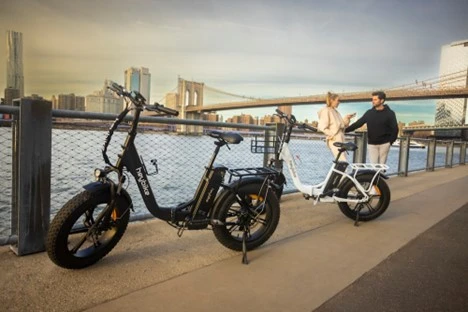Ohio eBike Laws – Need to Know?
If you are thinking to ride an electric bike in Ohio, it’s important to understand the state’s laws regarding these electric bicycles. However, eBikes are convenient and eco-friendly, it’s crucial to know the regulations to ride safely and legally. This article will explain Ohio’s eBike legislation, answering common questions and providing important details. Let’s embark on this journey of knowledge.
Defining Electric Bikes in Ohio:
To understand the eBike laws in Ohio, it’s important to know about the different types of electric bikes recognized in the state. Ohio has three main classes of eBikes, each with different motor power and functions. It’s crucial to be familiar with these classes because the regulations may vary depending on which class your eBike belongs to.

Class 1 eBikes:
Class 1 eBikes in Ohio are considered low-speed electric bicycles. They have a special feature called a pedal assist system (PAS), which means the motor only works when the rider is pedaling. This system provides assistance while pedaling, but the bike can only go up to 20 miles per hour. If you want to go faster, you have to pedal without the help of the motor.
Class 2 eBikes:
In Ohio, there are also Class 2 eBikes that have both pedal assist and throttle assist functions. This means they can move forward even without pedaling, thanks to the throttle assist feature. However, the maximum speed they can reach with assistance is 20 mph. If you want to go faster, you have to pedal.
Class 3 eBikes:
Class 3 eBikes rely only on pedal assist for movement and do not have a throttle assist feature. When the rider pedals, the motor provides assistance, allowing the bike to go up to 28 mph. It’s important to note that Ohio law requires all Class 3 eBikes to have a speedometer that shows the current speed.
Do you need a license for electric bike in Ohio?
A recurring question regarding eBike legislation in Ohio pertains to licensing requirements. The good news is, in most cases, obtaining a license is unnecessary for operating an electric bike within the state. However, exploring this topic in more depth is crucial to understanding the intricacies involved.

The Definition of Motor Vehicles:
It’s important to look at how Ohio law defines motor vehicles to understand why electric bike riders in Ohio are not required to have a license. Electric bikes, because of their lower speed and power, are not considered motor vehicles according to the law. Resultantly, people who ride electric bikes are not obligated to get a license like those who operate motor vehicles.
Exceptions and Limitations:
It is important to note that exceptions and limitations exist with respect to the license exemption. Electric bikes surpassing specific parameters may be categorized as motor vehicles, warranting the operator to possess a valid driver’s license.
In Ohio, electric bikes are generally defined as bicycles equipped with fully functional pedals for human propulsion and an electric motor outputting 750 watts or less. Adhering to this criteria is vital to qualify for the license exemption. Additionally, modifications that enhance an electric bike’s speed or power output may disqualify it from the license exemption. Thus, strict adherence to the defined specifications ensures riding an electric bike in Ohio without a license.
Consideration of Local Regulations and Municipalities:
Even though Ohio state laws don’t require licenses for electric bike riders, you should check the rules and regulations specific to your local area. As some cities or counties may have additional rules or restrictions that you need to follow. It’s a good idea to familiarize yourself with these local regulations to make sure you’re operating your electric bike lawfully and responsibly in Ohio.
The adjacent road speed limit:
Electric bikes in Ohio are classified into three categories based on their maximum speed capabilities. Class 1 eBikes, with a maximum speed of 20 mph or less, are generally permitted on all roadways where traditional bicycles are allowed. Comprehending give way and warning rules becomes crucial for riders to ensure the safety of pedestrians and themselves.
Give Way and Warning Rules
When riding an eBike in Ohio, it’s essential to follow give way and warning rules to ensure the safety of both riders and pedestrians. Just like traditional bicycles, eBike riders must yield the right-of-way to pedestrians on sidewalks and in crosswalks.
Age Restrictions and Helmet Requirements:
Considering the age of the rider is a critical aspect when riding an electric bike in Ohio. According to state law, riders under the age of 16 must wear a helmet while operating a Class 3 eBike. To minimize the risk of injuries, it is advisable for riders of all ages to prioritize protective headgear.
Factoring in Bike Wheel Size:
Ohio’s eBike legislation takes into account the size of the bike’s wheels. If the electric bike’s wheel diameter is less than 20 inches, it falls under the classification of a low-speed electric bicycle. Specific regulations, such as operable pedals and a motor with a maximum power output of 750 watts, govern these bikes.
Can you ride an e-bike on the sidewalk:
Riding an electric bike on sidewalks remains a topic of debate and confusion. Understanding the regulations surrounding sidewalk riding in Ohio requires closer examination.

Prioritizing Safety:
When riding an electric bike on the sidewalk, ensuring pedestrian safety is paramount. Observing a safe speed, being mindful of pedestrians, and allowing ample space when passing are essential practices. Pedestrians possess the right-of-way on sidewalks, and acknowledging their presence and prioritizing their safety is imperative.
Local Variations:
Ohio’s regulations regarding sidewalk riding may exhibit variations from one city to another. While some municipalities permit electric bikes on sidewalks, others restrict their use to roadways and designated bike lanes. Familiarizing oneself with the specific regulations in the area helps avoid potential legal complications.
Shared-Use Paths:
Shared-use paths, such as bike trails and multi-use paths, offer a popular avenue for cyclists and eBike riders. Electric bikes are typically permitted on these paths, provided riders remain considerate of other users, adhere to posted rules and speed limits, and yield to pedestrians. Maintaining a safe speed fosters a harmonious and enjoyable experience for all path users.
Opting for Roadway Riding:
In cases where sidewalk riding is prohibited or deemed unsafe, eBike riders in Ohio have the option to ride on roadways. As long as the electric bike adheres to the defined specifications, riders can operate them on roads where traditional bicycles are permitted. However, it is essential to observe all traffic laws, signal turns, and exercise caution when sharing the road with motor vehicles.
Is It a Good Idea to Ride an e-Bike on the Sidewalk?
When considering whether it is a good idea to ride an e-bike on the sidewalk, there are important factors to take into account. While it may seem convenient, safety should be the primary concern. Sidewalks are primarily designed for pedestrians, and the increased speed and weight of an e-bike can pose a risk to both the rider and pedestrians.
Pedestrians may not anticipate the presence or speed of an e-bike, potentially leading to accidents or collisions. Additionally, local regulations and municipalities may have specific rules regarding e-bike use on sidewalks. It is essential to be aware of these regulations to ensure compliance with the law. Ultimately, the decision to ride an e-bike on the sidewalk should prioritize safety and consider the well-being of pedestrians sharing the space.
Conclusion:
In conclusion, acquiring a comprehensive understanding of Ohio’s eBike legislation is indispensable for individuals considering electric bike usage in the state. Familiarize yourself with the various eBike classes, wheel size requirements, and age restrictions. While a license is typically not required, it is crucial to remain cognizant of exceptions and local regulations. When it comes to sidewalk riding, prioritizing pedestrian safety and adhering to specific rules is vital. By navigating Ohio’s eBike laws diligently, riders can relish the freedom of electric biking while ensuring compliance and safety.
FAQs:
Are electric bikes permitted on all roadways in Ohio?
Electric bikes with a maximum speed of 20 mph or less are generally allowed on all roadways where traditional bicycles are permitted.
Is a license necessary to ride an electric bike in Ohio?
In most cases, a license is not required to operate an electric bike in Ohio. However, exceptions exist based on the bike’s specifications.
Are there any age restrictions for riding an eBike in Ohio?
Riders under the age of 16 are mandated to wear a helmet when operating a Class 3 eBike in Ohio. Wearing protective headgear is recommended for riders of all ages.
Can electric bikes be ridden on sidewalks in Ohio?
Regulations concerning sidewalk riding of electric bikes may vary across municipalities in Ohio. Familiarizing oneself with local rules and restrictions is essential.
Are electric bikes allowed on shared-use paths in Ohio?
In most cases, electric bikes are permitted on shared-use paths, such as bike trails and multi-use paths. However, riders should be considerate of other path users and comply with posted rules and speed limits







